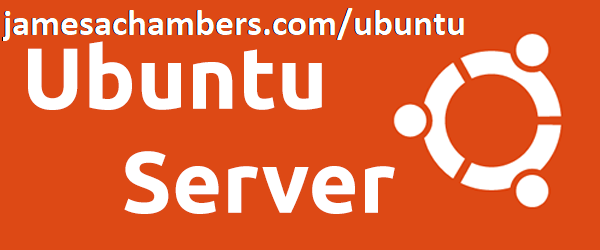
UPDATE 12/5/20 – New instructions are available for Ubuntu 20.04 or Ubuntu 20.10 installation and USB booting on Raspberry Pi 4 in my new article here
Ubuntu Server has been my favorite Linux distribution for years. On everything but the Raspberry Pi I run Ubuntu Server but felt stuck with Raspbian on the Pi. Until now! Ubuntu Server 18.04.2 has been released and major improvements have been made to the official Pi branch.
The Raspberry Pi 4 is not officially supported out of the box yet on the current Ubuntu Server Raspberry Pi images but you can get it working by manually updating the firmware. Solid state storage is also working but with the catch of having to use a micro SD card as a bootloader since the Pi 4 does not have official boot support yet. I describe how to do both in this article.
The Raspberry Pi’s peripherals such as WiFi / Bluetooth are now fully supported. Previous Ubuntu Server versions for Raspberry Pi (like many other distros) had broken or completely missing drivers for core components such as WiFi / Bluetooth. In the 18.04.2 update the firmware for the WiFi and other components is now included out of the box making it a fully functional distribution!
This is the first distribution besides Raspbian that feels like you can just image it and everything works. I’ll guide you through the process in this guide. It only takes a few minutes to set up.
Recommended Gear
I highly recommend upgrading to a solid state setup. The performance gains are gigantic. It’s now less than 30 bucks to take your Pi solid state. This is the best performance upgrade you can possibly get for a Pi.
With the new Raspberry Pi 4 it’s even more beneficial to use USB storage since a USB 3.0 bus was finally added in the Pi 4 letting it take full advantage of solid state drives. This is the setup I am currently using:

The Raspberry Pi 4 is available in different memory configurations all the way up to 8 GB. It’s about the size of a credit card and uses an extremely low amount of power making it ideal for all sorts of projects and ideas!
Links: AliExpress*, Amazon.com*, Amazon.ca*, Amazon.com.au*, Amazon*.co.jp*, Amazon.co.uk*, Amazon.de*, Amazon.es*, Amazon.fr*, Amazon.it*, Amazon.nl*, Amazon.pl*, Amazon.se*, Amazon.sg*

The Raspberry Pi 400 kit includes everything you need for a full Pi 400 desktop build. The Pi 400 is the fastest Raspberry Pi ever released and comes in the form factor of a keyboard!
Links: AliExpress*, Amazon.com*, Amazon.ca*, Amazon.com.au*, Amazon.co.jp*, Amazon.co.uk*, Amazon.de*, Amazon.es*, Amazon.fr*, Amazon.it*, Amazon.nl*, Amazon.pl*, Amazon.se*, Amazon.sg*

The Kingston A400 has been a great drive to use with the Pi for years. It’s reliable, widely available around the world, has low power requirements and performs very well. It’s also very affordable. This drive has been benchmarked over 1000 times at Pi Benchmarks and is the #1 most popular SSD among the Pi community!
Links: AliExpress*, Amazon.com*, Amazon.ca*, Amazon.com.au*, Amazon.co.jp*, Amazon.co.uk*, Amazon.de*, Amazon.es*, Amazon.fr*, Amazon.it*, Amazon.nl*, Amazon.pl*, Amazon.se*, Amazon.sg*
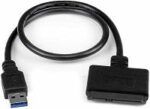
The USB 3.1 variant of the StarTech 2.5″ SATA adapter works well with the Pi 4. The USB 3.0 variant doesn’t have firmware updates available and is not recommended.
Links: Amazon.com*, Amazon.ca*, Amazon.com.au*, Amazon.co.jp*, Amazon.co.uk*, Amazon.de*, Amazon.es*, Amazon.fr*, Amazon.it*, Amazon.nl*, Amazon.pl*, Amazon.se*, Amazon.sg*
Or for a compact setup:

The SanDisk Extreme Pro USB SSD is a true solid state drive. This is different than a typical “flash drive” which uses extremely cheap memory and has very low random I/O performance/throughput compared to a real solid state drive. I’ve used both the USB 3.1 and USB 3.2 variants with the Pi successfully and they benchmark very well!
Links: AliExpress*, Amazon.com*, Amazon.ca*, Amazon.com.au*, Amazon.co.jp*, Amazon.co.uk*, Amazon.de*, Amazon.es*, Amazon.fr*, Amazon.it*, Amazon.nl*, Amazon.pl*, Amazon.se*, Amazon.sg*
SD Card Setup:
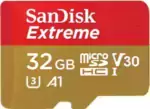
The SanDisk Extreme A1-A2 SD card has the best scoring SD card on Pi Benchmarks for years and is second in popularity only to the SanDisk Ultra (often included in combo kits). The application class (A1) means random I/O speeds (very important when running an OS) have to meet a higher standard. There’s no benefit on the Pi for A2 right now so get whichever is cheaper/available.
Links: AliExpress*, Amazon.com*, Amazon.ca*, Amazon.com.au*, Amazon.co.jp*, Amazon.co.uk*, Amazon.de*, Amazon.es*, Amazon.fr*, Amazon.it*, Amazon.nl*, Amazon.pl*, Amazon.se*, Amazon.sg*
These storage choices are ones that all scored highly on the end-user submitted Raspberry Pi Storage Benchmarks and will give you outstanding I/O performance on the Raspberry Pi. I also personally own all of them and recommend them knowing they are compatible and perform well on the Pi.
Getting Ubuntu Server
64 bit (aarch64)
I have a custom compiled prebuilt 64 bit image available for testing. This version supports addressing all 4 GB of RAM if available. The WiFi fix for bootflags3 is also already implemented into the precompiled version. Get my custom built kernel from the Ubuntu-Server-raspi4-unofficial GitHub page.
32 bit (armhf)
To get the 32 bit version head to the official Ubuntu Raspberry Pi page at https://wiki.ubuntu.com/ARM/RaspberryPi and scroll to the “Official Images” section. Until the official Raspberry Pi 4 image is released choose the Raspberry Pi 3B+ armhf release and follow the directions in the next sections to update the firmware for a Pi 4 boot.
Writing the Base Image
This part is easy. Extract the image from xz format to img format (7zip is great and free and can extract these). Now write the img to your media (Micro SD card, solid state drive, USB storage, etc). the same way you would for any other distribution!
Updating Firmware for Raspberry Pi 4
If you are using the CloudKernel 64 bit image you can skip to the “Boot Ubuntu Server” section as it already implements the updated firmware. If you are using the 32 bit image or the official Ubuntu Server preinstalled server image from Ubuntu’s web site you will need to update the firmware using these instructions.
Remove Existing Firmware
The firmware in the current release was not built with Raspberry Pi 4 support so we need to update the firmware on the /boot/ partition for the Pi 4 to be able to boot correctly.
Insert/mount the micro SD card in your computer and navigate to the “boot” partition. Delete everything in the existing folder so it is completely empty.
Download Latest Firmware
32 bit Firmware Instructions
If you are trying to run the 64 bit version of Ubuntu skip to the 64 bit instruction section next. For 32 bit versions of Ubuntu download the firmware from the official GitHib repository here: Raspberry Pi GitHub Official – master.zip
The latest firmware is everything inside master.zip “boot” folder (including subfolders). We want to extract everything from “boot” (including subfolders) to our micro SD’s “boot” partition that we just emptied in the previous step. Don’t forget to get the “overlays” folder as that contains overlays necessary to boot correctly.
The end result will look something like this on the “boot” drive:
$ ls COPYING.linux bcm2711-rpi-4-b.dtb kernel.img LICENCE.broadcom bootcode.bin kernel7.img 'System Volume Information' cmdline.txt kernel7l.img bcm2708-rpi-b-plus.dtb config.txt overlays bcm2708-rpi-b.dtb fixup.dat start.elf bcm2708-rpi-cm.dtb fixup4.dat start4.elf bcm2708-rpi-zero-w.dtb fixup4cd.dat start4cd.elf bcm2708-rpi-zero.dtb fixup4db.dat start4db.elf bcm2709-rpi-2-b.dtb fixup4x.dat start4x.elf bcm2710-rpi-3-b-plus.dtb fixup_cd.dat start_cd.elf bcm2710-rpi-3-b.dtb fixup_db.dat start_db.elf bcm2710-rpi-cm3.dtb fixup_x.dat start_x.elf
64 bit Firmware Instructions
To boot Ubuntu Server in 64 bit mode we need to download the 64 bit version of the firmware. The .dtb files are different between 32 bit and 64 bit operating systems. Raspbian does not come with a 64 bit bootloader and one isn’t provided in the official GitHub repo either.
I have these 64 bit versions available in my Ubuntu Server precompiled image.
Create/Update config.txt and cmdline.txt
Navigate to the micro SD /boot/ partition. Create a blank cmdline.txt file with the following line:
dwc_otg.fiq_fix_enable=2 console=ttyAMA0,115200 kgdboc=ttyAMA0,115200 console=tty1 root=/dev/mmcblk0p2 rootfstype=ext4 rootwait rootflags=noload net.ifnames=0
Next we are going to create config.txt with the following content:
# Enable audio (loads snd_bcm2835) dtparam=audio=on [pi4] [all]
64 bit config.txt Configuration
To boot the Pi in 64 bit mode we need to add the following lines to the config.txt:
arm_64bit=1 enable_gic=1 armstub=armstub8-gic.bin
The final configuration for 64 bit will look like this:
# Enable audio (loads snd_bcm2835) dtparam=audio=on [pi4] arm_64bit=1 enable_gic=1 armstub=armstub8-gic.bin [all]
These enable all the different 64 bit related options you need to perform a 64 bit boot on the Pi.
Boot Ubuntu Server
We are now ready to boot the device. Insert the micro SD card and power on the device.
Note: The very first startup can be very slow. Be patient. It can take up to a couple minutes with no activity lights then all the sudden everything will start blinking and SSH will open up.
Fix apt-get update / Prevent Further Updates
If you try to apt-get update now it will try to update your firmware with older firmware from the Ubuntu repository. The workaround for now is to remove that package so it keeps your existing firmware. Make a note to remember you did this step as later on we will want to reenable updates from the repository once support has been added.
sudo apt-mark hold flash-kernel
You may now run sudo apt-get update && sudo apt-get upgrade. I would avoid using dist-upgrade yet because the kernels in the repository it will update you to don’t support the Pi 4 yet. But this should get you all up to date on the packages!
Once the firmware in the apt repositories has been updated for the Pi 4 it will be safe to reinstall initramfs-tools and let it update through the normal process again.
Solid State Drive (SSD) Configuration (Optional)
USB booting has not been added into the Raspberry Pi 4 firmware yet but is being worked on right now. In the mean time you can use your micro SD card as a bootloader and still boot the whole operating system (rootfs) from the solid state drive giving you the full USB 3.0 speed increases system wide. Once the Pi USB booting is officially released you should be able to boot directly from the device without any makeshift bootloader SD card necessary.
First create a fully imaged and booting micro SD card following the earlier steps in the tutorial. After you have created the micro SD installation you should now image your SSD / USB drive with the same Ubuntu image you used to create the SD card.
Now navigate to the “boot” partition on the newly created SSD / USB drive and remove everything in there just like we did with the SD card earlier. Now copy the “boot” folder from the micro SD card to the solid state drive. This is necessary because even though the files in “boot” are read off our micro SD card initially some firmware files in the later load stages are read off the mounted drive and if the necessary firmware files are missing the system won’t boot.
Now that you’ve created the SSD / USB drive partitions and copied the “boot” partition from the SD card to your new drive we need to update your SD card’s cmdline.txt to point to the SSD / USB drive’s partition.
dwc_otg.fiq_fix_enable=2 console=ttyAMA0,115200 kgdboc=ttyAMA0,115200 console=tty1 root=/dev/mmcblk0p2 rootfstype=ext4 rootwait rootflags=noload net.ifnames=0
The key part we need to change here is the “root=/dev/mmcblk0p2” section. mmcblk0p2 is a hardware identifier for micro SD storage. We need to change this to the device your storage is detected as.
If you are using a USB to solid state drive adapter it’s very likely your drive will be addressed as /dev/sda2. Therefore we will change the root=/dev/mmcblk0p2 to root=/dev/sda2
root=/dev/sda2
The final line will be:
dwc_otg.fiq_fix_enable=2 console=ttyAMA0,115200 kgdboc=ttyAMA0,115200 console=tty1 root=/dev/sda2 rootfstype=ext4 rootwait rootflags=noload net.ifnames=0
Plug both the micro SD and the solid state drive into the Pi and boot it up.
Remember: the first boot can take 2-3 minutes for first startup so give it some time before assuming it didn’t work.
Wireless Fix
The current non-free Raspberry Pi firmware had the wrong bootflags3 for quite a while for the Raspberry Pi 4 and these firmware files are definitely out there. Here is a one liner I wrote to replace the Raspberry Pi 3 boot flags in this driver with the Raspberry Pi 4 one:
sudo sed -i "s:0x48200100:0x44200100:g" /lib/firmware/brcm/brcmfmac43455-sdio.txt
Restart the system afterward.
Configuration
Default User / Password
The username and password for your initial login to Ubuntu Server will be:
user: ubuntu password: ubuntu
You will be required to change your password after logging in for the first time. Make sure on the prompt you enter the current “ubuntu” password before typing in your new password or the device will kick you out completely and you’ll have to log in again.
Set Time Zone
To configure the correct time zone for Ubuntu Server use the following command:
sudo dpkg-reconfigure tzdata
This will take you to a very easy to follow menu to select your correct time zone and applies it to the system.
Update System
For best stability, security and performance you should immediately update your system and packages to the latest version. This will also grab all of the latest fixes/improvements making your Raspberry Pi Ubuntu experience much better.
This part is easy. Type:
sudo apt-get update && sudo apt-get upgrade
Change Default GPU Memory Split
The default amount of memory allocated to the GPU on the Raspberry Pi is around 76 MB of our 1 GB. In 2 GB and 4 GB models the amount gained from this is negligible but is still worth it for the 1 GB model.
If you type the command “free” you will see that your Raspberry Pi is missing this memory under the “total” column. We can reclaim most of this memory back by setting the GPU memory split to 16 MB. If you are planning on installing a GUI in the future you should not make this change.
This option is set in the config.txt file. It’s exactly the same file as Raspbian uses but it is located at /boot/firmware/config.txt instead of /boot/config.txt. Open config.txt with the following command:
sudo nano /boot/firmware/config.txt
We will add the following line at the bottom of config.txt:
gpu_mem=16
Press Ctrl + X and type yes to save the file. Now restart the Pi by typing
sudo reboot
After the reboot finishes type “free” again and you will see that your total available memory has increased and can now be used by the system and your applications!
Benchmarking / Testing Storage
If you want to verify your drive’s performance you may want to run my storage benchmark with:
sudo curl https://raw.githubusercontent.com/TheRemote/PiBenchmarks/master/Storage.sh | sudo bash
If you search for the model of your drive on Pi Benchmarks you can compare your score with others and make sure the drive is performing correctly!
Conclusion
I’m very excited to see my favorite Linux distributions continue to evolve to the point where they are comparable in performance and stability to Raspbian. I’ve been testing extensively on Ubuntu Server 32 bit and 64 bit for my Raspberry Pi Minecraft Server project and not only is it on par with Raspbian but starting to do things so well it sometimes makes Raspbian feel a little dated.
If you have any questions or suggestions don’t hesitate to leave me a comment on the post or use my contact form to message me privately! I’m good about responding quickly and my articles are constantly revised to address questions or do something a better way that a reader pointed out.
Have fun!





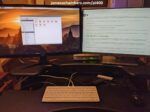

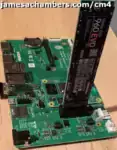
I followed the 32-bit directions, and it works up to a point; the system boots up and gets on the network, but I’m connecting an Apple Magic Keyboard via USB and it doesn’t work; console is unresponsive to keyboard input but I can ssh into whatever IP eth0 picks up from DHCP.
(My usb keyboard works fine with everything else including Raspbian Buster on the Pi 4, so this is odd….)
Hey Adam,
Have you tried in both the blue USB 3.0 ports and black USB 2.0 ports?
It may be worth typing sudo lsusb to see if anything is being detected when it’s plugged i.
Hi James,
Connecting a Logitech wired USB keyboard worked for me. So the Apple keyboard does show up (but doesn’t work):
Bus 001 Device 004: ID 05ac:0267 Apple, Inc.It doesn’t seem to matter which USB port the Apple keyboard is connected to, no luck with it so far.
At least the Logitech works!
You probably want to copy the modules (for the right version) into /lib/modules – that seemed to fix mine
I’m using a wired keyboard (generic) and am unable to type anything at the login screen, have tried the other USB ports.
When you say copy the right module versions… I see 3 directories at that location. How would I determine the right ones to copy into /lib/modules.
Sorry – not entirely sure why my comment appeared as a reply to your keyboard issue, it was supposed to be a reply to Tom’s issue with modules (JULY 12, 2019 AT 6:01 AM). You need the ones that match your kernel version (uname -r)
Can’t get this working for the Pi4, just sits there with a blank screen. Still it’s early days and I look forward for the official release!
Hey James,
I think we’re all expecting it to get dramatically better very soon as they update their preinstalled server image for the Pi 4. For now it’s definitely kind of hacky and some configurations still aren’t working.
The second I hear of it coming out everything will be updated!
thanks for the tutorial, as some code is 64bit only these days… =)
After trying the bootloader patch, I find the system reboots never after trying:
sudo shutdown -r now
Yet this seems to work fine, after a powercycle:
sudo shutdown -h now
Thanks for your instructions. I wrote the Ubuntu image on the SD card, but I do not find the boot partition. Should not be a folder on the SD card?
Hey lbrahim,
It definitely should just be a folder on the SD card (FAT format for boot). Try writing the image then ejecting the card and plugging it back in (sometimes that works for me if it doesn’t show up right away).
Thanks for these detailed instructions, they have been really helpful in trying to get a 64bit OS running on a pi 4.
I’m having an issue with getting the 64bit version working fully, but I’m not sure if I have misunderstood your instructions, or possibly even just how raspi bootloading works.
When I clear out the boot partition and replace it with the contents of the bootfs from the archive provided by sakaki, that also replaces the kernel8.img, which then means I’m not booting the ubuntu kernel, and the kernel modules fail to load on boot as it’s looking for modules in /lib/modules/4.19.56-v8+ (which doesn’t exist) rather than the 4.15.0-1031-raspi2. It does still boot successfully, but I can’t get things that rely on kernel modules to work (LVM for instance). Is this the intended behaviour, or am I doing something wrong?
Hey Tom,
Great questions! Once you boot into Ubuntu can you try copying the files from rootfs to the Pi? This is the /lib/modules/4.x folder for the newer kernel.
Thanks James, I ended up compiling the raspi kernel for arm64 and using the modules and kernel from that with the raspi3 arm64 ubuntu image, but your suggestion would have been the sensible option.
Now I’m just waiting for proper 2711 v8 support (or for a suitable workaround for the 1GB ram limit).
You probably want to copy the modules (for the right version) – that seemed to fix mine. Version obviously to match the kernel (uname -r)
Any idea on when we can get rid of the 1024 ram limit for the 64bit os? The main reason i for the rpi4 was to have more ram?
I think when the official Ubuntu images for Raspberry Pi 4b would come, they would have support for full RAM. Hoping they release them soon.
Using the steps mentioned, the armhf version of Ubuntu boots but the arm64 version gets stuck on multicolored screen and the boot doesn’t proceed.
I think firmware that was downloaded only support 32bit is right now.
Also, I got an error while upgrading the system using apt-get.
Hey Altback,
I’ve updated the article with the 64 bit instructions!
Thank you. I am testing it right now.
It booted up.
But I got the following errors while updating and upgrading:
Setting up initramfs-tools (0.130ubuntu3.8) ...update-initramfs: deferring update (trigger activated)
Processing triggers for initramfs-tools (0.130ubuntu3.8) ...
update-initramfs: Generating /boot/initrd.img-4.15.0-1031-raspi2
W: mkconf: MD subsystem is not loaded, thus I cannot scan for arrays.
W: mdadm: failed to auto-generate temporary mdadm.conf file.
Unsupported platform.
run-parts: /etc/initramfs/post-update.d//flash-kernel exited with return code 1
dpkg: error processing package initramfs-tools (--configure):
installed initramfs-tools package post-installation script subprocess returned error exit status 1
Errors were encountered while processing:
initramfs-tools
E: Sub-process /usr/bin/dpkg returned an error code (1)
Very nice, glad you got in!
Ubuntu is trying to update the firmware with an older version from their repository. The workaround for now is to remove that package.
sudo apt remove flash-kernel initramfs-toolsYou may now run sudo apt-get update && sudo apt-get upgrade but *don’t* use dist-upgrade yet because the kernels in the repository it will update you to don’t support the Pi 4 yet. But this should get you all up to date on the packages!
Thank you, that did it. Packages did got updated.
I noticed one thing on reboot after logging into user it said some packages are available for upgrade out of which few are security updates.
But, when I again ran the command for update and upgrade, nothing was there to be updated.
Anyways, this will keep me going for testing Ubuntu 18.04.02 LTS on Raspberry Pi 4b.
I tried few packages. Virtualmin installation failed because few packages were not found in the repository. I think lot of packages don’t have their ports for ARM64/32. But, the most common packages are available.
Again, thank a lot for the prompt updates.